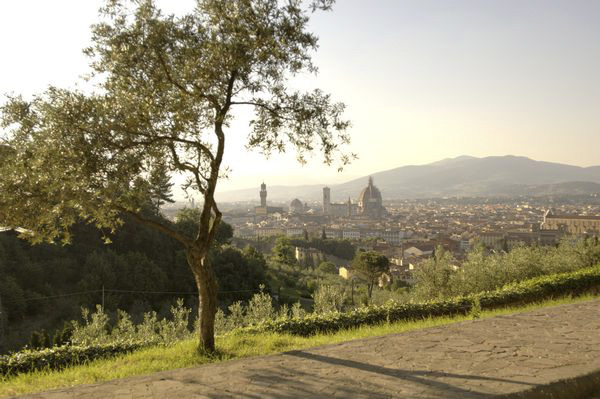Italy’s ‘Yellow’ Zone Timetable of Reopenings

Before the pandemic, there were small moments in daily routines, from ordering a caffè macchiato at your favorite bar to lifting weights at the gym, which many long for after months of isolation. With COVID-19 cases dropping and the beginning phases of vaccinations picking up, Italy has issued a new decree which will take effect on April 26 and will be valid until July 31. Its aim is to re-introduce intrinsic elements of daily life while still following health regulations. Below is the current information; for a quick summary, watch this video here.
Color change and movement between zones
While Tuscany was in the “orange” and second most at-risk zone beginning April 17 (based on the number of factors (rate of infection, number of available hospital beds in Covid wards and intensive care), both the region and the city of Florence are expected to move to the less risky “yellow” zone. While anti-Covid measures will be more lenient, “yellow” status still maintains a 10 pm curfew until June 1, ditto for “orange” and “red” zones. It will also be possible to travel between regions classified as “yellow.” To cross the borders of “orange” and “red,” a person must carry either a self-certification form stating movement for a work, health, or necessity; another alternative is a required “green pass.” This electronic or physical paper will prove that you have either not had COVID-19 in the past six months, been vaccinated, or had a nose swab in the past 48 hours. The pass must be certified by a medical professional. Homes in “yellow” and “orange” zones can now host up to four visitors once a day, in addition to the handicapped and kids 14 and under. Hopefully, this small but meaningful improvement will soon extend to regions currently still in red.
Opening of schools and universities
On April 26, middle and high school students in “yellow” and “orange” areas will be able to return to their desks with schools at a 70 to 100 percent capacity, while those living in “red” regions will continue to follow a rotational schedule that allows for in-person attendance at a 50 to 75 percent capacity. All students in elementary school will return to the classroom.
Return of restaurants and bars
Although takeout and delivery will continue, restaurants, bars, pubs, cafés and gelaterias with outdoor seating in “yellow” zones will be able to reopen and serve lunch and dinner, keeping in mind the 10 pm curfew in mind. This will be a difficult adjustment as almost 50 percent of restaurants in Italy do not offer patio dining. No more that four people can sit at the same table unless they are relatives. Sidewalk table tax will be waived in Florence for the rest of the year. Food will not be allowed to be served inside until June 1 when health officials will have a better understanding of how these new measures have impacted the pandemic. There remains, nonetheless, a promise of returning to the simple pleasure of sitting down and ordering a hazelnut gelato as a midday treat.
Cinemas and theaters reopen at half capacity, museums with limitations
Event venues such as movie theaters in “yellow” areas will reopen on April 26 to 50 percent of their full capacity, with a maximum of 500 people inside and 1,000 outside. Seats must be reserved beforehand either by calling or online and members of the audience must sit a meter (3.2 ft. apart). This was the proposal made by Dario Franceschini, minister of culture. The ministry has also indicated that special events can be organized, but specific protocols will need to be met, such as the aforementioned health pass.
Museums and galleries located in “yellow” regions, which applies to at least three-quarters of Italy, will also be able to reopen on weekdays starting on the 26th, but, however, remain closed on the weekends given the concern of an influx in visitors. Each museum will provide a reservation system and capacity limits as well as require the mandatory wearing of masks.
Beaches, swimming pools, gyms, and museums will reopen according to safety protocols
At the end of the month, amateur contact sports will be allowed outdoors with venues running at a 25 percent capacity limit and a maximum of 500 spectators indoors, 1,000 outdoors.
To go for a swim, you will have to wait a little bit longer, until May 15. Beach resorts will require at least one-meter distance between sun beds, pools two meters (6.5 ft.) of social distancing and 7 to 10 square meters between each swimmer.
Gyms, too, will not reopen until June 1 and will require two meters of social distancing, mandatory measuring of your temperature and sanitizing of equipment, and proper ventilation. It will be possible to use the showers and changing rooms, but still following the same social distancing guidelines.
Fairs startup, too and spa resorts will reopen
Hot springs and spa resorts will not open until July 1 and will require reservations. Amusement parks will once again welcome guests starting on the same day; safety protocols are being worked out.
Trade fairs and conferences can once again take place beginning July 1, although protocols are still in the works in determining entry and exit strategies, screening of workers, social distancing, and mask-wearing. Visitors who come from EU countries to attend an event must quarantine for five days beforehand, 14 days for guests arriving from the rest of the world.
Overall, the decree promises more freedom within the realm of safety as Italy navigates how to return to its somewhat regular programming after surpassing the one year mark since the onset of the pandemic. These improvements appear small, but is it the little things that individuals once took for granted which mean so much more after months without the ability to even chat over a bowl of pesto pasta with your neighbor. (elizabeth berry)
